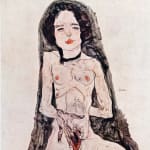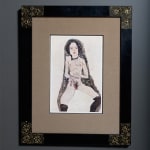Egon Schiele Austrian, 1890-1918
1920
Further images
Published anonymously c. 1920, Vienna, in an edition of 100, after the original gouache, watercolor and pencil on paper, signed and dated in the plate by the artist in middle right: “S. 10.”; printed in color and marked in the lower right by the printer: “AK.” who is believed to be Andreas Krampolek.
This work, its original watercolor purportedly now lost, relates to a series of works in pencil, watercolor and gouache which Schiele likely undertook upon his return to Vienna in the Fall of 1910. Having just spent the better part of five months in the small town of Krummau where Schiele had envisioned starting an artists’ colony, he had left there discouraged by the group dynamic but more committed than ever to devote his life to his work. Hereafter, Schiele would indulge his own curiosity and his own inclinations.The final months of 1910 were a turning point in Schiele’s art. His expressionistic style for which he has come to be known emerged at this time. In this rendering of a woman masturbating, Schiele rejects contextualization or the use of artistic conventions of beauty. Giving emphasis to sinewy limbs and taught musculature in the torso, Schiele conflates androgyneity with femininity. Hiding the left hand behind the back in a manner suggestive of being bound, the right hand is quite large and unnaturally dexterous. With thumb and fifth finger spanning from navel to the thigh, the middle fingers vigorously massage the vagina. Darkened finger tips indicate the application of pressure on fleshy body parts, and the effect of this friction is evident in the darkly depicted genitalia. Schiele had embarked on a life-long quest of exploring all aspects of human sexuality in an effort at coming to terms with his own psychological pathos. Viewing this image, one feels Schiele’s resolve to resist and overcome social obstacles. One senses Schiele’s determined spirit on a quest for autonomy and self-empowerment. Exploring an act of self-pleasure was, ultimately for Schiele, a means of gaining more self-awareness and knowledge about his inner self for his own sake.
As much as Schiele’s images cover bold territory, the portfolio itself has a colorful history all its own. It is one which involves censorship, destruction and trials about morality. Born out of the lofty ideas and ambitions of artists and art lovers, the portfolio represents state of the art printing in its day as well as art as interstate commerce. The erotic subject matter of Schiele’s five images included in the portfolio necessitated discretion. The portfolio printed in an edition of 100 was published anonymously. The one-time printing, as it states on the cover page, was only for subscribers. Thus, from the portfolio’s inception, there is an implication of secrecy and exclusivity. Even the printer’s contribution is cryptic. Save for the discreet initials inconsistently marked on each printed sheet, no mention is made about the printer, its whereabouts or even the year in which the portfolio was created.
Scholars now believe the printer to be Andreas Krampolek (1869-1940), a Viennese art printer specializing in the collotype process. Upon his 40th anniversary of printing in 1923, Krampolek’s work was honored with an exhibition at Vienna’s Museum of Art and Industry. That same year was also a critical one in the story of the portfolio. In September, Karl Grunwald was tried before the Regional Court for Criminal Affairs in Vienna. Accused of disseminating pornographic prints, Grunwald was charged with a violation of the law on moral grounds. The prints in question were none other than the EGON SCHIELE: FUNF ZEICHNUNGEN portfolio. Grunwald had sent this portfolio to Hans Goltz in Munich who was a former art dealer of Schiele. Grunwald offered Goltz 200 sheets, or the equivalent of 40 portfolios, for purchase. Goltz declined the offer and returned the portfolio of Schiele prints to Grunwald in Vienna. Customs authorities intercepted the package and brought charges against Grunwald. Although a jury found Grunwald to be Not Guilty of any crime, the 200 sheets from the portfolio did not fare as well. Attorney General Hofrat Formanek pushed for a separate hearing with the intention of destroyingg the 200 images. In a bold act of censorship which recalled a similar outcome in court during Schiele’s lifetime, the art prints were destroyed by the court authorities. By late-1923, only 60 portfolios remained.
Karl Grunwald and Egon Schiele had met one another several years prior during the war early in 1917. Leopold Liegler, one of Schiele’s art patrons, intervened on Schiele’s behalf in an effort to get Schiele transferred out of combat duty and back to Vienna where he could better focus on his art. Appealing to Grunwald’s sensitivity for and appreciation of the arts, Liegler suggested the Military Supply Depot in Vienna where Grunwald was stationed as an option for Schiele. Indeed, through Grunwald’s help, Schiele was transferred there on 12 January, 1917. In Grunwald, Schiele found a champion. Grunwald modeled for Schiele and befriended him. By the Spring, Schiele had hatched his ambitious plan for an artistic gathering place. Schiele’s Kunsthalle was to be a public forum where poets, painters, sculptors, architects and musicians could freely interact. Among his recruits were leading artists such as Vienna Secession founders, Gustav Klimt and Hans Hoffmann; the composer Arnold Schoenberg and art patrons Liegler and Grunwald. One of the key features Schiele enthusiastically envisioned for Kunsthalle’s commercial possibilities was to act as “its own art dealer and publisher.”
Schiele’s print portfolios were the sole fruits of this dream. Though Schiele’s Kunsthalle died on the vine, his portfolios effectively superseded the fixed art exhibition space to create a mobile concept. In 1917 bookseller Richard Lanyi published the first series of Schiele’s reproduction prints to much critical and commercial success. Following the war, Grunwald opened the gallery, Alte und Moderne Kunst in Vienna. He remained committed to Schiele, even after his untimely death in 1918, by staging an exhibition of Schiele’s work in 1921. It was only natural that Grunwald would continue Schiele’s commercial and artistic vision by publishing his own portfolio of Schiele works. FUNF ZEICHNUNGEN was Grunwald’s great contribution to Schiele scholarship. That some of the original 100 have survived is all the more significant because without this portfolio, the public today would not have a record of two key works by Schiele which, sadly, were lost during the Nazi era.





